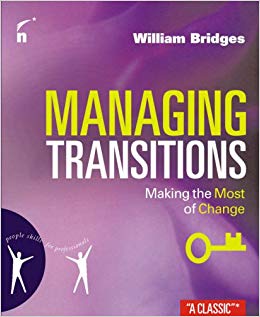Everyone experiences transition at work. It can be as dramatic as a seismic shift in the outlook of the business or as basic as someone familiar leaving the firm, the loss of a loyal supporter. The key is to recognise a transition point when you reach one, and to handle it well.
First, is a ‘transition’ the same thing as change? Actually, no. They’re different, as explained by William Bridges: .
“Change is situational. Transition, on the other hand, is psychological. It is not those events but rather the inner reorientation or self-redefinition that you have to go through in order to incorporate any of those changes into your life. Without a transition, a change is just a rearrangement of the furniture. Unless transition happens, the change won’t work.”

William Bridges’ transition model
So change is merely a new situation presenting itself, while transition is the personal transformation which goes with change. The thing about transitions is, they’re usually harder to navigate than mere changes. We often have little real idea what the new beginning we’re heading towards might look like, and that can be tough to handle.
In Bridges’ world transition is a three phase process, a process where we gradually come to terms with a new situation and its implications. The first part of the process is the ending of the existing situation, which can bring about a fast cycle of uncomfortable feelings: denial, shock, anger, frustration, stress and – ultimately – ambivalence. On other occasions, the ending can be a relief. The relief can remain, but it usually diminishes quite quickly. It is then accompanied with traces of loss, plus uncertainty and a growing anxiety about what will happen next.
In the middle there’s a neutral zone, a place Bridges calls No Man’s Land. This is at the heart of transition. It can be slower, disorientating and involves first anxiety, confusion, then gradually acceptance and greater clarity. New meaning, hope and often enthusiasm start to emerge and the process moves into the final stage – the new beginning phase of the transition.

In the middle of the transition, there is no clear map for this territory, as it is an unknown land and needs careful navigation. It is a psychological journey across a never before travelled terrain to a new place. At the end of the process there’s frequently a fresh new beginning, but this does not emerge automatically and it usually takes time to get there, A measure of struggle is inevitable.
When in this phase, identity and directional questions need to be grappled with, explored from plenty of different angles and then decisions made.
Crucial questions like:
- What does the future hold for me now?
- Who am I? Who do I want to be onwards?
- What is meaningful to me?
- What is my purpose?
- Where am I headed?
- What do I have to offer or contribute?
- What are my professional core values?
- What is the narrative that makes sense here and I can take forwards?
- What options are available to me?
So how do you actually progress through these stages?
Tips to navigate the transitions in your working life
Transition is the process of adjusting to change. Are you currently in a state of transition in your career, or a transition at work? If so, there are some good, reliable ways to be resilient and cope well.
As mentioned earlier, every transition is a three-phase process: an ending, a neutral zone, and a new beginning. Here’s how you can make the most of the three stages and emerge at the other end feeling more hopeful and positive.
Step 1 – The ending stage

It might feel counterintuitive but every transition starts with an ending. Before you can start something new, you have to put an end to the old way of being.
- First, try to understand every aspect of the situation clearly in fine detail
- Look ahead and see the changes rolling out in front of you, one after the other
- Figure out the losses, who loses what, and make a list
- Know that losses can be either material, or highly subjective and emotional
- Don’t be surprised if you have a strong reaction, maybe grief, anger or relief
- Understand the power that something out of your control has to upset you
- Remain open and keep the information flowing
- Communicate carefully, don’t hide the facts but practise how you talk about them
Step 2 – The Neutral Zone
The neutral zone is a limbo, half way between old and new. Because there are few things trickier to handle in life than uncertainty, don’t expect yourself to behave in an orderly, logical way at this stage. This is the point where you realise there’s no going back.
- Keep your demands on yourself reasonable, with relatively low expectations
- Let yourself avoid some of the old ways of doing things, gently letting go
- Set concise short term goals to give yourself a morale boost
- Give yourself time to explore those crucial identity and directional questions
- Keep on communicating and seek support from others you trust and respect
Step 3 – A New Beginning

New beginnings tend to make us feel a blend of fear and excitement. But when people have real purpose and know where they’re going, change feels so much more tolerable. When you can picture the future, going beyond words alone, it’s easier to see the final destination in your mind’s eye. A plan helps – a transition plan rich in subjective, individual, emotional and psychological elements. When you’re part of the transition with a real role to play, new beginnings can feel super-exciting.
- Be consistent with the goals or you’ll lose focus
- Set some quick win, low risk goals to make you feel good
- Make full use of symbols or markers of your new beginning, for example a new logo and brand, a set of different work clothes or even a new hairstyle!
- Enlist the support of friends and colleagues who will encourage you
- Craft your narrative about your new start with realism, enthusiasm and positive intent
- Celebrate the new beginning and take one step at a time
Read the book by William Bridges
The book, Managing Transitions, is packed with extra insight and wisdom. You can pick up a copy on Amazon.
Help transitioning with confidence
Change is situational and objective. Transition is psychological and subjective. It can be a challenging task to navigate your way through significant transitional times in your professional career. If this is where you are right now, contact us. We will be pleased to discuss our coaching with you.
About us
We are a team of highly experienced executive coaches, focused on developing leaders working in high-stakes environments across diverse sectors. We create space for leaders to step back, think clearly, and navigate complexity with confidence and renewed purpose. Our narrative-based approach blends deep listening, incisive questioning and rigorous thinking with a strong commercial focus.
“Our Knowledge Centre is designed to resource leadership practice and development. The articles we share on this site are intended to spark fresh thinking, offer practical tools, and support continuous professional growth.”
Jude Elliman
Founder
Our approach
We work with leaders to build their leadership brand and impact. Our approach includes:
✔ Challenge and support: creating time and space for rigorous thinking and problem-solving
✔ Narrative coaching: defining and refining the stories that shape leaders and organisations
✔ Commercial focus: cutting through complexity for strategies that inspire change and drive results
We help leaders make crucial decisions, align teams for greater effectiveness, and envision new possibilities for the future.

